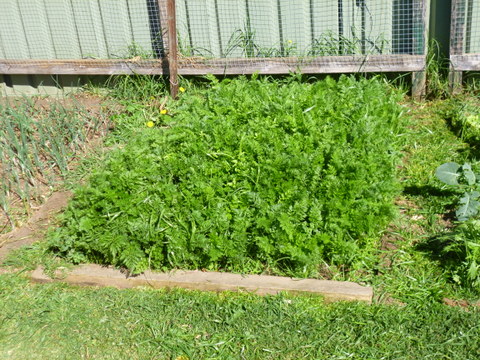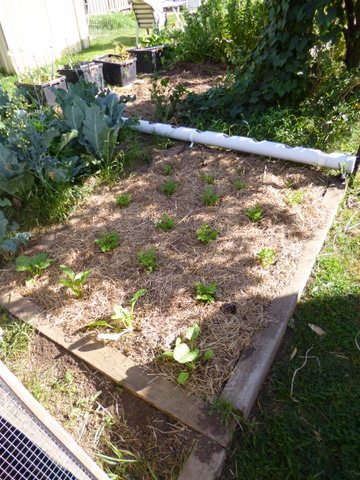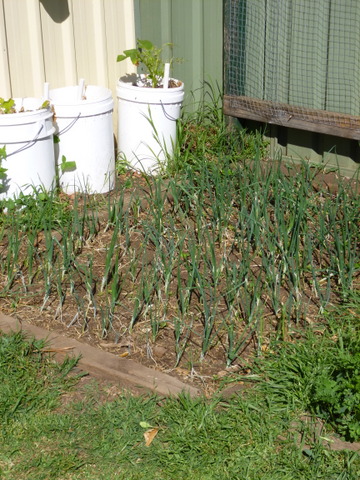A couple of conversations recently have got me thinking about crop rotation and how it works in our system. Crop rotation is the practice of not growing plants from the same family, in the same ground, year after year and the reasons for doing it make a fair bit of sense –
- You don’t get the same nutrients taken out by the same plants all the time so it helps to maintain soil fertility and
- There is less chance of getting a build up of pests and diseases of a particular crop because the soil gets a rest from it.
Some examples of crop rotation include -
1. A four course rotation – plant a “root” crop such as potatoes or carrots (to break up the ground), followed by a “legume” crop such as beans or peas (to put nitrogen into the soil), followed by a leaf crop such as lettuce or silver beet (to make use of the nitrogen) followed by an “other” crop such as brassicas (cauliflower; broccoli) or solanum (tomato; capsicum) or even a fallow period.
2. A three course rotation I have heard of that has been used in the UK is potatoes, followed by brassicas, followed by and “other” crop ie everything else.
3. Rotate by family – This simply means that you don’t sow plants from the same family in the same bed one after the other. The plant families are as follows
a. Alliums – onions, garlic, leeks, shallots, spring onions, chives
b. Beets (also referred to a chenopodiaceae) – beetroot, silver beet, spinach
c. Brassicas (also referred to as crucifers) – Brussels sprouts, cabbage, kohlrabi, cauliflower, broccoli, kale, radishes, turnips.
d. Compositae – salsify, endive, lettuce, globe artichoke
e. Cucurbits – cucumbers, melons, gourds, squash, pumpkins
f. Grains – sweet corn, dent corn, wheat, rye
g. Legumes – peas (dwarf and runner), beans (dwarf and runner), broad beans
h. Solanum – potatoes, tomatoes, egg plant, capsicum, chillies
i. Umbellifers – parsnip, parsley, carrots, celery, dill, fennel, coriander
The whole idea makes sense to me, until I tried and apply it in a back yard situation. If you are growing a whole load of cabbages, it makes sense not to follow the cabbage crop with a broccoli crop in the same ground. However If you are in a backyard situation and following other organic principles like interplanting your crops (ie mixing them up in the same bed), it makes things much more difficult, unless you want to keep up with unrealistic levels of note taking!
To me the idea of crop rotation is designed for large scale growers and in the back yard it becomes almost irrelevant. Even so great an authority as the Yates Garden Guide has this to say about crop rotation –
“In Australia, there is a natural rotation between warm and cool season crops. Providing you apply organic matter and are aware of the possibility of related crops contracting a disease from a previous crop, you need not be concerned about crop rotation”
Even having just demolished the idea, I have found that I do want some form of crop rotation in our backyard food production process. This is because the way we produce our food is that the beds, year round, will have some lettuce and some brassicas in them. In summer they will be interplanted with beans, other salad crops, etc and in winter they will be interplanted with spinach, peas etc, but that central theme will always be brassicas and lettuce. Again, this is because things like broccoli and cabbage will grow year round and they are also what we eat.
There are some crops which we tend to plant once as a whole bed and then harvest them over the greater part of a year such as carrots. There are other crops which have a longer bearing period than the 5 to 6 months allowed in our rotation between chooks or are slow growers and take a while to come to harvestable size. And example of the former is silver beet and an example of the latter is celery. If we interplant these crops as we would normally we are just starting to get a crop or they are well in stride when it is time for the chooks top come through and raze the place (as they do so well).
There are other crops which we plant once a bed at a time and then harvest all together, like our onion crop. Onions all get sown into boxes at the same time in April then planted out into a bed in spring, at the same time. And then we harvest them to store, all at the same time, and they keep well enough so that they are still ok by the time we get to the end. In practice we grow about 5-6 months worth of onions.
Likewise, corn. You have to plant corn in a block to get it to pollinate so we usually grow a bed or two of corn each summer, then harvest it over a fairly short time ( a week or two generally) and have corn parties! During the harvest time it is “corn with everything” for that couple of weeks.
Then there are the carrots! We plant a bed’s worth of carrots in late winter or early spring and that one bed is usually enough to see us through for the rest of the year. We eat the largest first and then the remainder grow into the space left, so that by the time they are starting to run up to seed in the following spring, the new carrot bed is just taking off (although sometimes we have problems and not enough come up like happened last year). The carrot bed gets a full year rest from brassicas and lettuce!
Up until now, which beds get the full plant out and which get the standard interplanting “lettuce and brassicas plus” line-up has pretty much depended on which bed was free when I wanted to do the planting. To help me remember which beds, have had what planted into them, when, I have developed a (you guessed it!) Excel spreadsheet. This will help me to keep track of when each bed had its last had its full bed cleaning crop. In that way I will be able to manage things better and ensure that every bed gets a relief from our standard crops at least once a year.
The system that we have in place now has worked well so far, but a bit of crop rotation can’t hurt!






